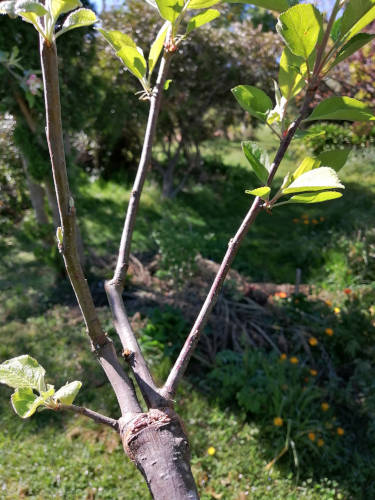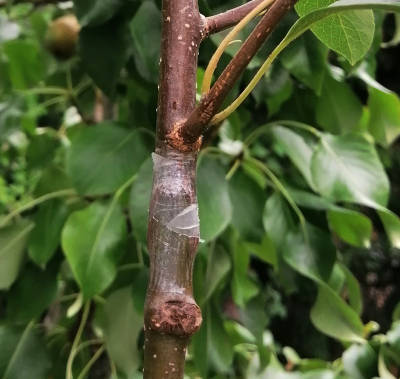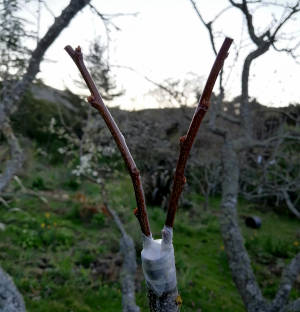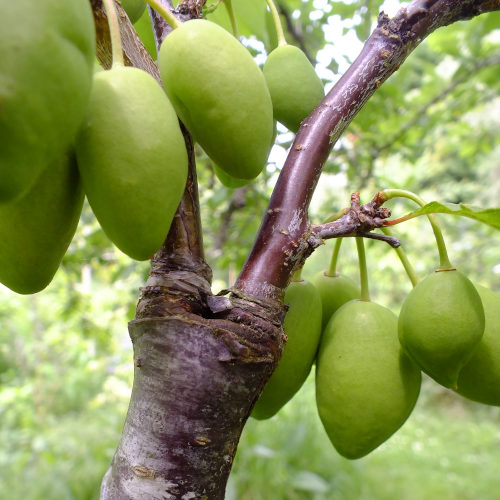Process for Creating a Multi-Grafted Deciduous Fruit Tree
- Select the Base Tree (Rootstock):
- Choose a healthy, established deciduous fruit tree (e.g., apple, pear, plum, or stone fruit) that is vigorous, disease-free, and compatible with the scion varieties you plan to graft. The tree should be 2–5 years old with a well-developed root system and a trunk diameter of at least 2–5 cm for grafting.
- Ensure the tree is suited to New Zealand’s climate and your specific region (e.g., ‘M26’ or ‘MM106’ rootstock for apples in Canterbury or Auckland). Compatibility between rootstock and scion is critical to avoid graft failure.
- Choose Scion Varieties:
- Select 3–5 scion varieties (e.g., different apple cultivars like ‘Gala’, ‘Fuji’, and ‘Granny Smith’) that are compatible with the base tree and suited to your region’s climate. Consider pollination requirements, fruit ripening times, and disease resistance to ensure a balanced and productive tree. Check our available scion list
- Collect dormant scions in winter (June–August in New Zealand) from healthy, one-year-old shoots with several buds. Each scion should be 20–30 cm long. Store them in a cool (0–4°C), moist environment (e.g., wrapped in damp cloth in a refrigerator) until spring grafting.
- Drastic Pruning of the Base Tree:
- In late winter to early spring (August–September), before grafting, heavily prune the base tree to reduce its canopy by 50–70%. This minimizes competition for nutrients and energy, allowing the tree to focus on healing graft unions and supporting new scion growth. It also ensures the grafted varieties become significant portions of the final multi-graft tree.
- Remove older, unproductive branches, leaving 3–5 strong scaffold branches or a central leader, depending on the tree’s structure. Cut back remaining branches to outward-facing buds to promote an open canopy. Make clean, angled cuts to prevent water pooling and disease entry.
- For larger trees, consider cutting back to the main trunk or major branches to create grafting sites, especially for cleft or bark grafts.
- Prepare Tools and Materials:
- Gather a sharp grafting knife, pruning shears, grafting tape or parafilm, and grafting sealant (e.g., wax or pruning paint). Sterilize all tools with alcohol to prevent disease transmission.
- Ensure scions are fresh and hydrated before grafting. If stored, it is suggested to soak them in water for a few hours before use to prevent drying out.
- Grafting in Spring:
- Perform grafting in early to mid spring (September–October in New Zealand) when the base tree’s sap begins to flow, and temperatures are consistently 15–20°C, promoting graft union formation.
- Select grafting techniques based on the size of the scion and rootstock:
- Whip-and-Tongue Graft: For scions and rootstock of similar diameter (0.5–1.5 cm). Align cambium layers and secure tightly.
- Cleft Graft: For larger branches (2–5 cm). Insert 1–2 scions into a split branch.
- Bark Graft: For grafting onto the trunk or larger branches. Insert scions under the bark.
- Graft 3–5 different scion varieties onto separate branches or sections of the trunk to create the multi-variety tree. Ensure even distribution to promote balanced growth.
- Secure grafts with grafting tape and seal exposed cuts with grafting wax to prevent drying and infection.
Learn more about after care
Pruning for Balance (First 1–2 Years)
- Year 1 (Late Summer–Early Winter): In late summer or early winter (February–June), lightly prune the new scion growth to encourage branching and maintain balance among varieties. Remove any overly vigorous shoots from one variety to prevent it from dominating weaker ones. Aim for equal vigour across all grafted sections.
- Year 2 (Winter): Prune again to shape the tree and maintain balance. Remove crossing branches, water sprouts, or suckers. If one variety grows significantly faster, reduce its canopy more heavily to allow slower varieties to catch up. Aim for an even distribution of branches for each variety to ensure equal fruit production.
- Ongoing Balance: Some varieties (e.g., ‘Granny Smith’ apples) may naturally grow more vigorously. Regularly prune these to prevent them from overshadowing less vigorous varieties (e.g., ‘Fuji’). Maintain an open canopy to ensure sunlight reaches all grafted sections.
Long-Term Maintenance (Years 3 and Beyond)
- Annual Pruning: Prune each winter to maintain tree structure, remove dead or diseased wood, and balance the growth of different varieties. Ensure each grafted section has sufficient space and light. Thin fruit if necessary to prevent overbearing, which can weaken the tree.
- Pollination and Fruit Production: Monitor pollination compatibility. Some multi-graft trees may need cross-pollination (e.g., certain apple varieties). If needed, plant nearby pollinators or graft a pollinator variety onto the tree.
- Soil and Nutrition: Test soil every 2–3 years to ensure nutrient balance. Apply compost or mulch annually to maintain soil health, especially in New Zealand’s variable soils. Adjust fertilization based on tree vigour and fruit yield.
- Pest and Disease Management: Continue monitoring for regional issues like black spot or codling moth. Use integrated pest management practices, such as pheromone traps, to minimize chemical use.
Achieving a Balanced Multi-Variety Tree
- Key to Balance: The initial drastic pruning of the base tree ensures that new grafts receive enough resources to establish and grow into significant portions of the tree. Ongoing pruning is critical to prevent vigorous varieties from dominating and to maintain an even canopy. Aim for each grafted variety to contribute 20–33% of the total canopy (depending on the number of varieties).
- Monitoring Growth: Regularly assess the vigour of each grafted section. If one variety lags, reduce pruning on its branches and increase pruning on stronger varieties. Adjust watering and fertilization to support weaker sections.
- Fruit Production: A balanced multi-graft tree will produce varied fruit types with staggered ripening times, extending the harvest season. For example, grafting early (‘Gala’), mid-season (‘Fuji’), and late (‘Granny Smith’) apple varieties ensures fruit from summer to autumn.




